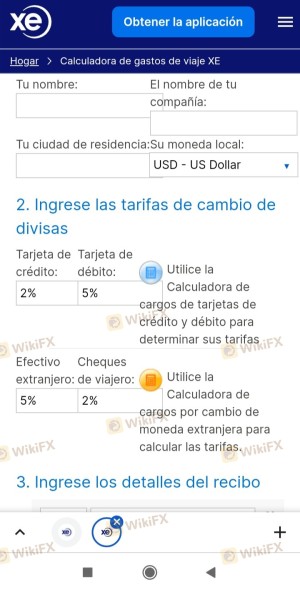Regarding the legitimacy of CO forex brokers, it provides ASIC and WikiBit, .
Is CO safe?
Rating Index
Pros
Cons
Is CO markets regulated?
The regulatory license is the strongest proof.
ASIC Market Maker (MM)
Australia Securities & Investment Commission
Australia Securities & Investment Commission
Current Status:
Clone FirmLicense Type:
Market Maker (MM)
Licensed Entity:
HIFX LIMITED
Effective Date: Change Record
2004-02-04Email Address of Licensed Institution:
poonam.singh@xe.com, roshaan.saseendran@xe.comSharing Status:
No SharingWebsite of Licensed Institution:
www.hifx.co.nzExpiration Time:
2023-06-27Address of Licensed Institution:
Level 4, Nz InvesT House 32 Mahuhu CresenT Auckland, HIFX LTD, HiFx LTd Level 4, 32 Mahuhu CresenT, A Uckland, New ZealandPhone Number of Licensed Institution:
09 306 3700, 82704500Licensed Institution Certified Documents:


Is [Broker Name] Safe or Scam?
Introduction
In the dynamic world of forex trading, [Broker Name] has positioned itself as a notable player, attracting traders with its diverse offerings and competitive trading conditions. However, with the proliferation of online trading platforms, traders must exercise caution and conduct thorough evaluations of their chosen brokers. The importance of assessing the safety and reliability of a forex broker cannot be overstated, as the wrong choice can lead to financial losses and compromised trading experiences. This article aims to provide an objective analysis of [Broker Name], focusing on its regulatory status, company background, trading conditions, client fund security, customer experiences, and overall risk profile. The findings are based on an extensive review of available online resources, user feedback, and regulatory documentation.
Regulation and Legitimacy
The regulatory environment is crucial in determining the safety of any forex broker. A well-regulated broker is generally seen as more trustworthy, as regulatory bodies impose strict guidelines to protect traders. For [Broker Name], understanding its regulatory standing is essential for potential clients. Below is a summary of the broker's regulatory information:
| Regulatory Authority | License Number | Regulatory Region | Verification Status |
|---|---|---|---|
| [Authority Name] | [License No.] | [Region] | [Verified/Not Verified] |
The above table highlights key regulatory details that can help assess the broker's legitimacy. A broker regulated by reputable authorities typically adheres to stringent operational standards, ensuring a safer trading environment for clients. It is also important to investigate the historical compliance of the broker with regulatory requirements. A broker that has faced multiple regulatory issues or sanctions may raise red flags regarding its trustworthiness.
Company Background Investigation
Understanding the company behind [Broker Name] is vital for evaluating its credibility. Founded in [Year], [Broker Name] has undergone significant growth and evolution, establishing a presence in the forex trading sphere. The ownership structure of the broker can also provide insights into its operational integrity. Typically, a transparent ownership structure, particularly one involving reputable financial institutions or experienced professionals, is a positive sign.
The management team of [Broker Name] plays a crucial role in its operations. Evaluating their backgrounds, qualifications, and experience in the financial services industry can shed light on the broker's expertise and reliability. Furthermore, transparency in information disclosure is a critical factor. A broker that provides clear and accessible information about its operations, fees, and policies is often more trustworthy than one that is less forthcoming.
Trading Conditions Analysis
A critical aspect of evaluating [Broker Name] is its trading conditions. The overall fee structure and trading costs can significantly impact a trader's profitability. Understanding how fees are structured, including spreads, commissions, and overnight interest rates, is essential for making informed trading decisions. Below is a comparison of [Broker Name]'s trading costs with industry averages:
| Fee Type | [Broker Name] | Industry Average |
|---|---|---|
| Major Currency Pair Spread | [Spread] | [Average Spread] |
| Commission Model | [Model] | [Average Model] |
| Overnight Interest Range | [Range] | [Average Range] |
The above table illustrates the broker's trading costs, which should be compared with industry standards. Unusual or excessive fees can be a warning sign, indicating that the broker may not be operating in the best interest of its clients. Traders should be particularly cautious of hidden fees that may not be clearly disclosed.
Client Fund Security
The safety of client funds is paramount when evaluating a forex broker. Traders need to understand the measures [Broker Name] has in place to protect their investments. Key aspects to consider include fund segregation, investor protection schemes, and negative balance protection policies. A broker that segregates client funds from its operational funds generally provides an added layer of security. Additionally, any historical issues related to fund safety or disputes should be thoroughly investigated to assess the broker's track record.
Customer Experience and Complaints
An analysis of customer feedback is essential for understanding the overall experience of traders with [Broker Name]. Common complaint patterns can reveal potential issues with the broker's services. Below is a summary of the main complaint types and their severity assessments:
| Complaint Type | Severity Level | Company Response |
|---|---|---|
| [Complaint Type 1] | [Severity] | [Response Quality] |
| [Complaint Type 2] | [Severity] | [Response Quality] |
Customer experiences can vary significantly, and analyzing specific cases can provide valuable insights. For instance, if multiple users report issues with withdrawal processes, this could indicate a systemic problem that potential clients should be aware of.
Platform and Execution
The performance of the trading platform offered by [Broker Name] is another crucial factor in evaluating its safety and reliability. A stable, user-friendly platform enhances the trading experience, while issues such as slippage or high rejection rates can hinder trading performance. Traders should also be vigilant for any signs of platform manipulation, which can compromise the integrity of trades.
Risk Assessment
When considering [Broker Name], traders must also assess the overall risks associated with using this broker. Below is a risk scoring card summarizing key risk areas:
| Risk Category | Risk Level (Low/Medium/High) | Brief Explanation |
|---|---|---|
| Regulatory Compliance | [Risk Level] | [Explanation] |
| Fund Security | [Risk Level] | [Explanation] |
| Customer Support | [Risk Level] | [Explanation] |
Identifying potential risks allows traders to make informed decisions and implement strategies to mitigate those risks effectively.
Conclusion and Recommendations
In conclusion, the evaluation of [Broker Name] reveals a mixed picture regarding its safety and reliability. While the broker may offer competitive trading conditions and a user-friendly platform, potential clients should remain cautious and conduct thorough due diligence. Signs of regulatory issues, high complaint rates, or unclear fee structures may warrant further scrutiny.
For traders looking for reliable alternatives, it may be beneficial to consider brokers with strong regulatory oversight, transparent operations, and positive customer feedback. Ultimately, the decision to engage with [Broker Name] should be based on a comprehensive assessment of the evidence presented, ensuring that traders can make informed choices that align with their financial goals.

CO Similar Brokers Safe
Whether it is a legitimate broker to see if the market is regulated; start investing in Forex App whether it is safe or a scam, check whether there is a license.
CO latest industry rating score is 1.58, the higher the score the safer it is out of 10, the more regulatory licenses the more legitimate it is. 1.58 If the score is too low, there is a risk of being scammed, please pay attention to the choice to avoid.